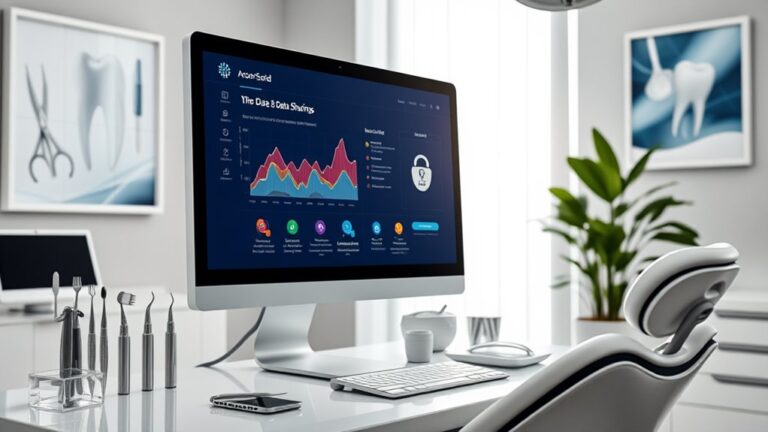Top Dental EHR Solutions for Seamless Practice Management
Much like a well-tuned orchestra, a successful dental practice requires harmony between various elements, and that's where top dental EHR solutions come in. You're probably aware that these systems can transform how you manage your practice, but have you considered the specific features that truly enhance efficiency? From real-time data access to robust patient engagement tools, the right EHR can make a significant difference in your daily operations. Understanding the nuances of these solutions could be the key to revealing your practice's full potential.
If you need assistance navigating these options, feel free to contact us. We can connect you with experts who can provide tailored solutions for your practice's unique needs.
Key Features of Dental EHR Solutions
Understanding the key features of dental EHR solutions is essential for optimizing practice efficiency and enhancing patient care. One critical aspect is patient profiling, which allows you to gather and analyze thorough medical and dental histories. This information helps you tailor treatments to individual needs, ensuring personalized care.
Another significant feature is the use of customizable templates. These templates streamline documentation for various dental cases, enabling you to efficiently record information during patient visits. This not only saves time but also reduces the likelihood of errors, enhancing accuracy in patient records. This is particularly important, as 68.5% of dentists utilized EHR in practices as of 2021, highlighting its growing acceptance in the field.
Moreover, incorporating clinical and diagnostic tools like integrated 3D modeling and dental charting improves your ability to visualize treatment progress and patient conditions. Real-time progress notes support ongoing treatment planning, ensuring you stay informed and proactive.
Additionally, patient management tools—including appointment schedulers and secure communication options—facilitate engagement, allowing you to follow up effectively and educate patients about their care.
With these features, dental EHR solutions empower you to provide high-quality, efficient care while optimizing practice operations. By leveraging these capabilities, you're better equipped to serve your patients and enhance their overall experience.
Benefits of Cloud-Based Systems
Cloud-based systems are revolutionizing dental practices by enhancing efficiency and productivity across various operations. By automating routine tasks like billing and submitting claims, you can streamline everyday processes, dramatically reducing manual paperwork. This automation minimizes human errors, allowing your staff to focus more on patient care rather than administrative tasks.
The centralized data storage offers quick access to patients' electronic medical records and other essential documents, ensuring compliance with regulations such as HIPAA. Additionally, cloud benefits include improved data security, as patient information is backed up in secure servers, protecting against physical disasters. This technology also frees up physical space in dental offices for additional patient rooms or equipment.
Accessibility and flexibility are key advantages, as you can access patient information 24/7 from any location, enabling real-time updates and automatic appointment reminders. This system scalability allows for easy coordination of care among providers and supports remote work for your team.
Lastly, enhanced security measures protect against cyber threats, ensuring patient records are always available, even during emergencies. By adopting cloud-based systems, you not only improve operational efficiency but also elevate the standard of care you provide, ensuring your practice thrives in a competitive landscape.
Integration Capabilities Overview
As dental practices increasingly rely on technology, integrating various software and medical devices becomes crucial for optimizing operations and enhancing patient care. Effective integration capabilities are critical, as they allow for seamless data interoperability across systems. This means your EHR can easily connect with medical billing software, practice management software, and e-prescription tools, streamlining workflows and minimizing errors.
Moreover, imaging software integration is essential. By connecting advanced imaging technologies like cone-beam computed tomography (CBCT) and intraoral scanners, you can enhance diagnostic accuracy and patient comfort. Real-time data exchange guarantees that the information from these devices flows smoothly into your EHR, allowing for thorough treatment plans and informed decision-making. Implementing customizable dental templates can further streamline documentation processes, ensuring that your practice remains efficient and organized.
Utilizing APIs for device connection further enhances your practice's efficiency. With standardized forms and charts, data entry becomes less cumbersome, promoting continuity of care. Additionally, integrating tele-dentistry tools encourages virtual consultations, broadening your service reach.
Ultimately, these integration capabilities not only improve practice management but also elevate patient engagement and care quality, positioning your practice as a leader in dental health.
Training and Support Options
Effective training and support options are vital for maximizing the benefits of your dental EHR system. To begin, assess your staff's current skills and training needs to pinpoint any gaps. Developing a targeted curriculum tailored to different roles guarantees everyone receives the specific instruction they need.
Consider the unique workflows of your practice and the requirements for various treatments to create a thorough training plan. Employing diverse training models can enhance learning. For instance, using a train-the-trainer approach allows your team to build internal expertise, while direct vendor training covers essential out-of-the-box functionalities.
Incorporating eLearning modules offers flexibility, enabling staff to learn at their own pace. Simulation training can provide hands-on experience in a risk-free environment, allowing staff to practice tasks like appointment scheduling and data entry. Tailored training approaches are essential for addressing diverse learning needs among staff.
Post-deployment, it's vital to maintain robust support resources. This includes monitoring the system's performance and providing ongoing training to guarantee proficiency. Establish a support line or help desk for troubleshooting to empower your staff.
Security and Compliance Measures
Maximizing the potential of your dental EHR system requires more than just effective training and support; it also demands rigorous security and compliance measures.
To protect patient privacy, verify your software complies with HIPAA regulations governing the security of protected health information (PHI). Implement data encryption, access controls, and audit trails to safeguard sensitive data from unauthorized access. Additionally, ensure that you regularly assess your software for HIPAA compliance to stay aligned with the latest regulations.
Establish clear policies for the collection and disclosure of patient health information, aligning with HIPAA and state laws. Regular training for your staff is crucial to verify everyone understands these regulations.
Proactively address cybersecurity threats by developing a robust breach response plan. This should include clear procedures for notifying affected individuals and regulatory bodies in the event of a data breach.
Conduct regular risk assessments to identify vulnerabilities in your systems and update your security measures accordingly.
Utilize unique user IDs and role-based access controls to manage who can view PHI, while maintaining audit logs to track access and modifications.
Finally, verify vendor agreements include provisions for security compliance, regular audits, and clear responsibilities in protecting patient data.
Enhancing Practice Efficiency
Efficiency in a dental practice hinges on the seamless integration of technology and streamlined workflows. By focusing on workflow optimization, you can greatly reduce administrative burdens and improve patient care.
Advanced scheduling tools that allow for drag-and-drop functionality and real-time availability can simplify appointment management, helping you make the most of each day. Color-coded appointments and automated reminders further minimize no-shows, ensuring patients arrive on time.
Task automation plays an essential role in enhancing practice efficiency. Automated check-in management alerts your staff when patients arrive, allowing for better time management. Cloud-based solutions offer flexibility and accessibility, enabling staff to manage tasks from any location.
Digital charting and auto progress notes streamline clinical documentation, reducing time spent on paperwork. Additionally, an integrated billing system simplifies financial processes, automating claims submissions and payment reminders.
Patient Engagement Tools
Engaging patients in their dental care is vital for fostering loyalty and improving overall satisfaction. Effective patient engagement tools can greatly enhance your communication strategies, guaranteeing that patients feel valued and informed throughout their dental journey.
Utilizing various communication channels like text messaging, email, and social media allows you to meet patients where they're most comfortable. Automated messaging systems streamline appointment reminders and follow-ups, reducing no-shows and enhancing patient satisfaction. Moreover, by employing omni-channel communication, you can cater to diverse patient preferences, ensuring everyone receives the information they need in their preferred format.
Furthermore, customizable templates enable you to send personalized messages that resonate with each patient. Integrating these tools with your practice management systems not only boosts efficiency but also fosters a seamless experience for patients.
For instance, allowing patients to book appointments directly through your website simplifies the process, making it easier for them to engage with your practice.
Security is imperative; all communications should be HIPAA-compliant and encrypted to protect patient confidentiality. By prioritizing secure, personalized communication, you're not just improving operational efficiency—you're actively building trust and loyalty.
Ultimately, adopting these patient engagement tools positions your practice for success by enhancing patient satisfaction and creating lasting relationships.
Real-Time Data Access
In today's rapidly evolving dental landscape, real-time data access serves as a cornerstone for enhancing patient care and practice operations. By integrating your dental EHR with practice management systems and telehealth platforms, you streamline administrative tasks and facilitate secure data exchange with general care providers. This connection allows for efficient workflows and a paperless environment, essential for modern practice management.
The HeyDonto AI API exemplifies real-time data processing, offering 100% access to standardized EHR data. It tackles data standardization, consolidating inconsistent entries—like insurance information—through Evolutionary Neural Networks. Utilizing secure interfaces for real-time data capture minimizes manual entry, empowering you to make informed decisions quickly.
Furthermore, robust security features, including access controls and audit trails, guarantee that patient information remains confidential and compliant with industry standards like HIPAA. With cloud-based solutions, you gain encrypted access to patient records from anywhere, enhancing flexibility while maintaining security. Cloud systems also facilitate better agility and convenience in practice management, ensuring that your team can respond promptly to patient needs.
Ultimately, real-time data access not only improves workflow efficiency but also elevates the quality of care you provide, fostering a more responsive and patient-centered dental practice.
Choosing the Right EHR Solution
Selecting the right EHR solution is essential for optimizing your dental practice's operations and enhancing patient care. To make an informed decision, you should define your EHR selection criteria based on your practice specific needs.
Consider functionality first—look for core features like patient profiling, appointment management, and clinical tools such as e-prescriptions and visual treatment planning. Additionally, ensure that the system offers comprehensive feature sets to address all aspects of your practice effectively.
Next, evaluate integration capabilities. Your EHR should seamlessly connect with billing systems, practice management software, and telehealth platforms to streamline workflows and improve patient engagement.
User-friendliness also matters; a simple interface reduces the learning curve for staff, allowing them to focus on patient care instead of struggling with technology.
Customization options are critical, too. Choose an EHR that adapts to your unique practice, whether you specialize in orthodontics or oral surgery.
Finally, prioritize security and compliance with HIPAA regulations to protect patient data. Research providers' reputations and verify they offer transparent pricing and reliable support.
Frequently Asked Questions
How Do Dental EHR Solutions Improve Patient Outcomes?
Dental EHR solutions enhance patient outcomes by boosting patient engagement and improving treatment efficiency. You'll notice streamlined communication and personalized care plans, leading to better adherence to treatments and ultimately, healthier patients.
What Are the Costs Associated With Implementing a Dental EHR?
Before diving into costs, consider your implementation budget. Software training, setup, and ongoing maintenance can range considerably. Investing wisely now can streamline your practice and enhance patient care, leading to long-term savings and efficiency.
Can EHR Systems Be Customized for Specific Dental Practices?
Yes, EHR systems can be customized to meet your specific practice requirements. Tailored templates, treatment plans, and integrated modules enhance efficiency, ensuring your practice operates smoothly while addressing the unique needs of your patients.
How Does a Dental EHR Ensure Data Portability?
A dental EHR guarantees data portability through data interoperability, allowing seamless sharing across systems. You gain secure access to patient information anywhere, promoting efficient communication and enhancing your ability to provide thorough, informed care to your patients.
What Are Common Challenges When Transitioning to a Dental EHR?
When shifting to a dental EHR, you'll face challenges like data migration complexities and the necessity for extensive staff training. Understanding these hurdles helps you strategically prepare your practice for a smooth implementation process.
Conclusion
In the realm of dental practice management, selecting the right EHR solution is akin to choosing the perfect instruments for a symphony; each feature plays a vital role in harmonizing your operations. By leveraging cloud-based systems and robust integration capabilities, you can not only enhance efficiency but also elevate patient care. As you navigate this landscape, consider reaching out to us for expert assistance. Our guidance can save you time, reduce stress, and significantly improve your dental practice. Remember, the right choice can transform your practice into a well-orchestrated masterpiece, ensuring that compliance and patient engagement resonate throughout. Let us help you achieve that harmony.





